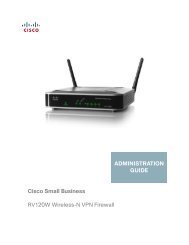Cisco WAP200 Wireless-G Access Point with PoE and ...
Cisco WAP200 Wireless-G Access Point with PoE and ...
Cisco WAP200 Wireless-G Access Point with PoE and ...
You also want an ePaper? Increase the reach of your titles
YUMPU automatically turns print PDFs into web optimized ePapers that Google loves.
<strong>Wireless</strong>-G <strong>Access</strong> <strong>Point</strong> <strong>with</strong> Power Over Ethernet <strong>and</strong> RangeboosterAppendix B: <strong>Wireless</strong> SecurityLinksys wants to make wireless networking as safe <strong>and</strong> easy for you as possible. The current generation ofLinksys products provide several network security features, but they require specific action on your part forimplementation. So, keep the following in mind whenever you are setting up or using your wireless network.Security PrecautionsThe following is a complete list of security precautions to take (as shown in this User Guide) (at least steps 1through 5 should be followed):1. Change the default SSID.2. Disable SSID Broadcast.3. Change the default password for the Administrator account.4. Enable MAC Address Filtering.5. Change the SSID periodically.6. Use the highest encryption algorithm possible. Use WPA if it is available. Please note that this may reduceyour network performance.Note: Some of these security features areavailable only through the network router oraccess point. Refer to the router or accesspoint’s documentation for more information.7. Change the WEP encryption keys periodically.To ensure network security, steps one through five should be followed, at least.Security Threats Facing <strong>Wireless</strong> Networks<strong>Wireless</strong> networks are easy to find. Hackers know that in order to join a wireless network, wireless networkingproducts first listen for “beacon messages”. These messages can be easily decrypted <strong>and</strong> contain much of thenetwork’s information, such as the network’s SSID (Service Set Identifier). Here are the steps you can take:Change the administrator’s password regularly. With every wireless networking device you use, keep in mindthat network settings (SSID, WEP keys, etc.) are stored in its firmware. Your network administrator is the onlyperson who can change network settings. If a hacker gets a hold of the administrator’s password, he, too, canchange those settings. So, make it harder for a hacker to get that information. Change the administrator’spassword regularly.Appendix B: <strong>Wireless</strong> SecuritySecurity Precautions47
















